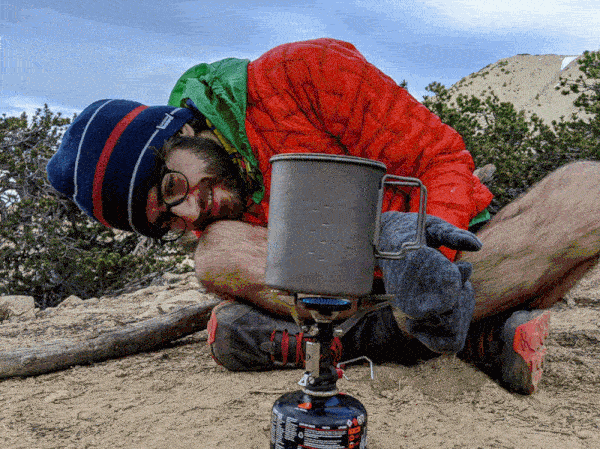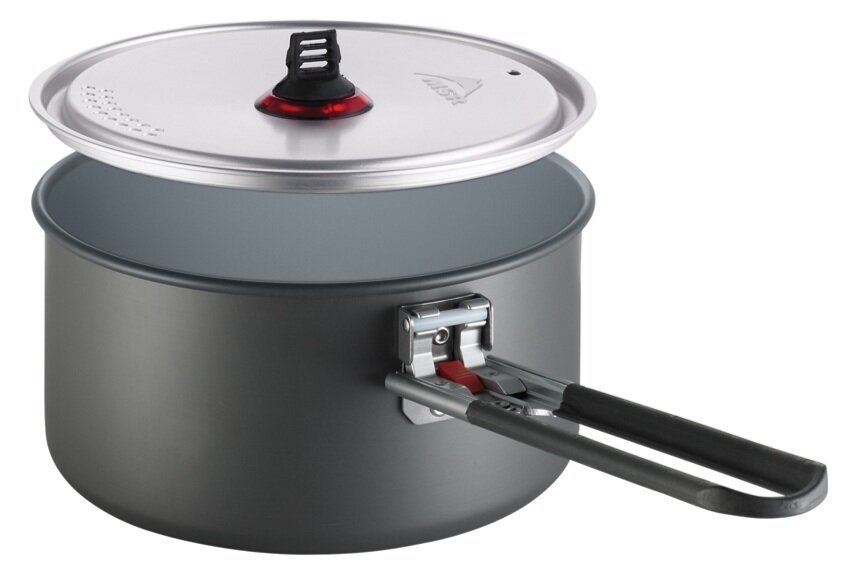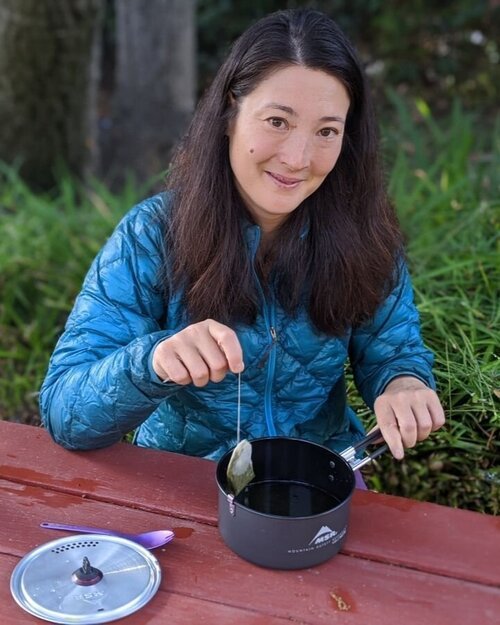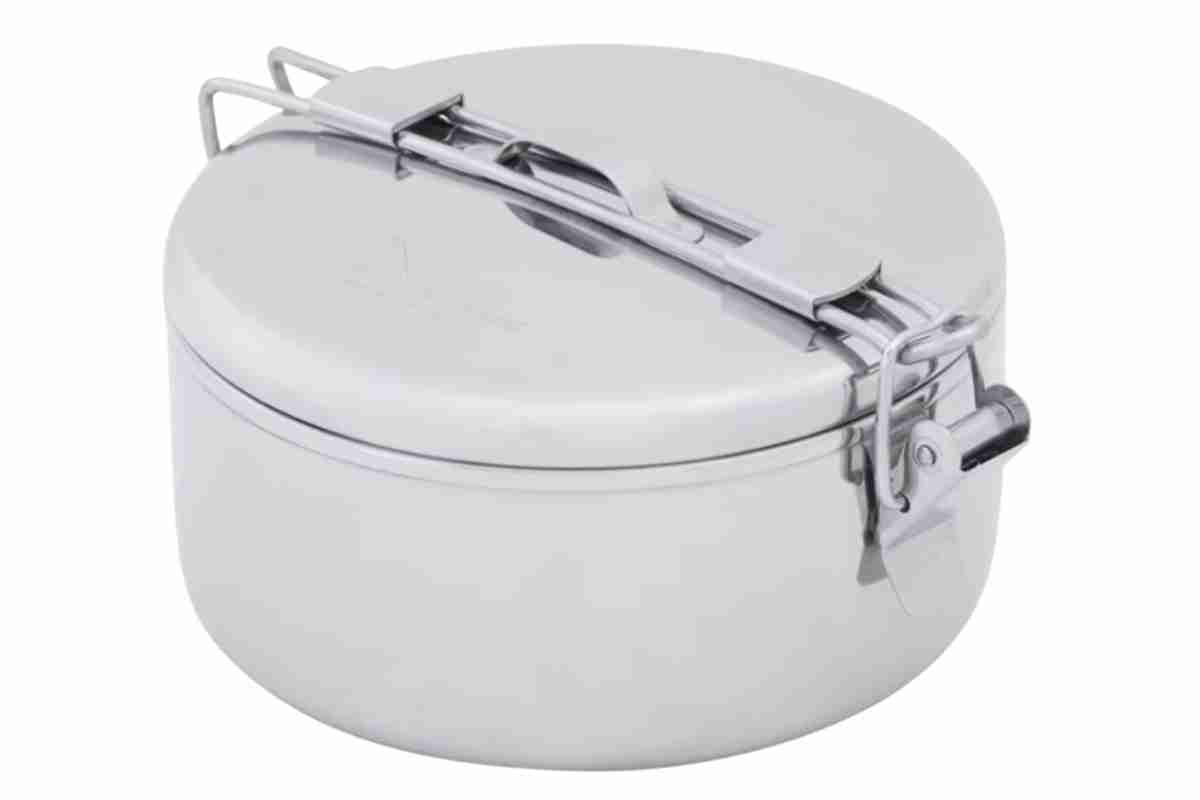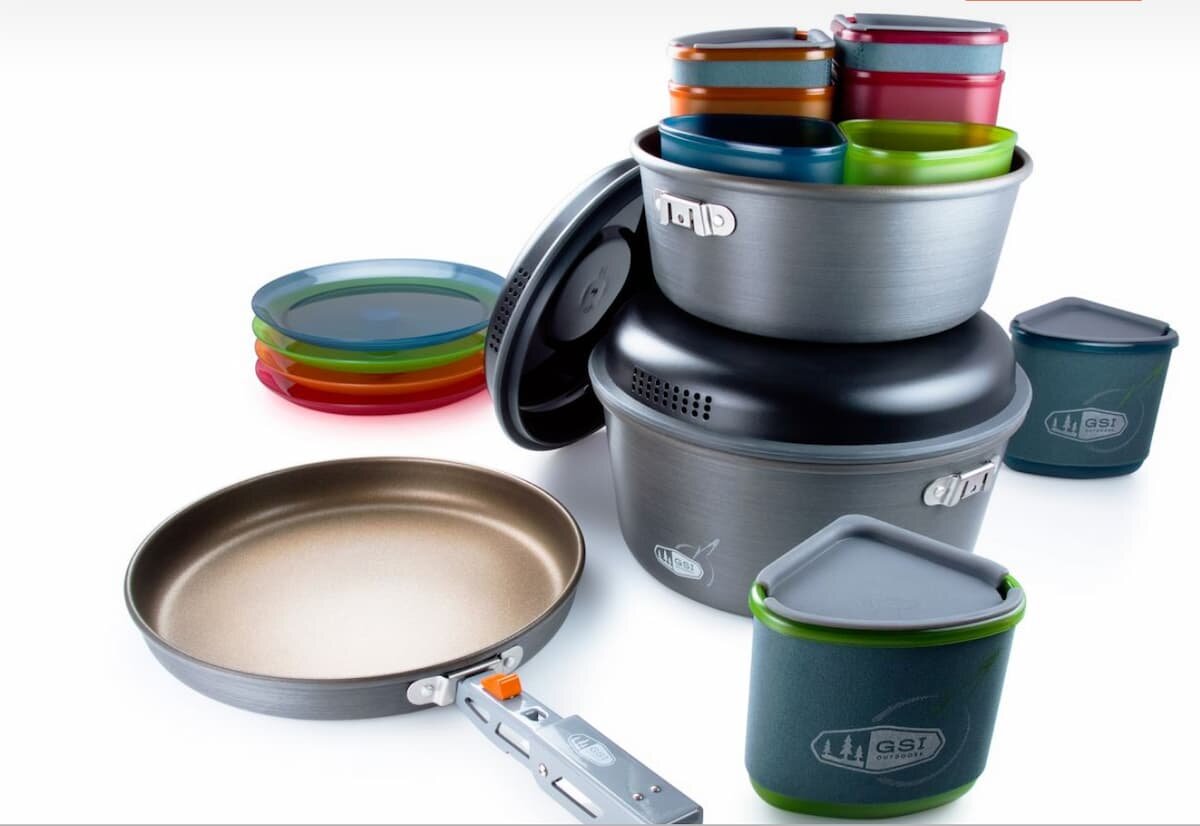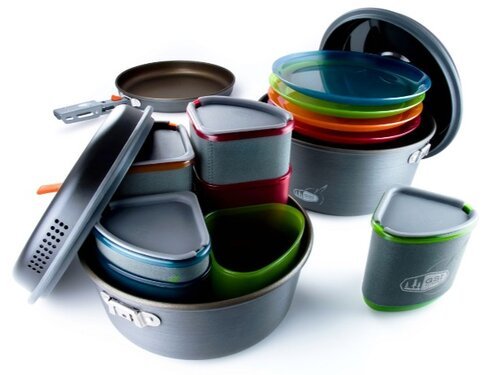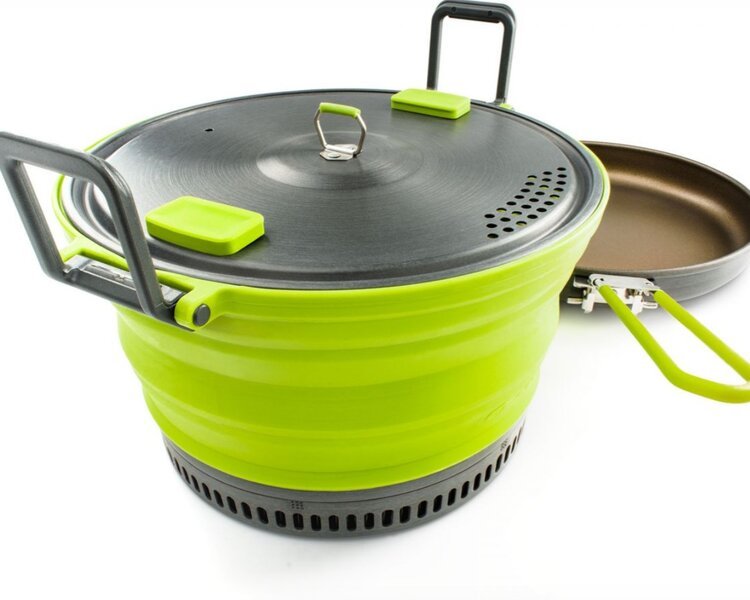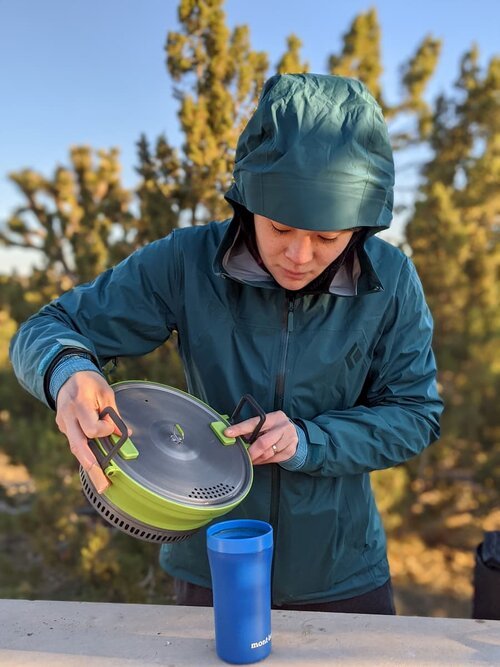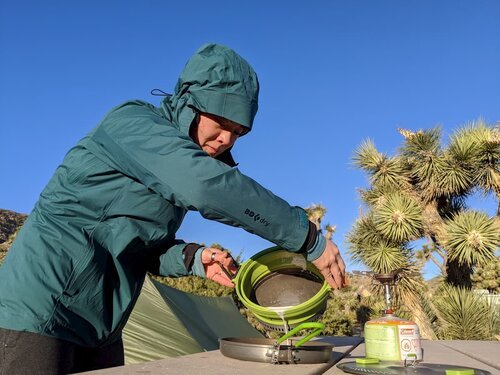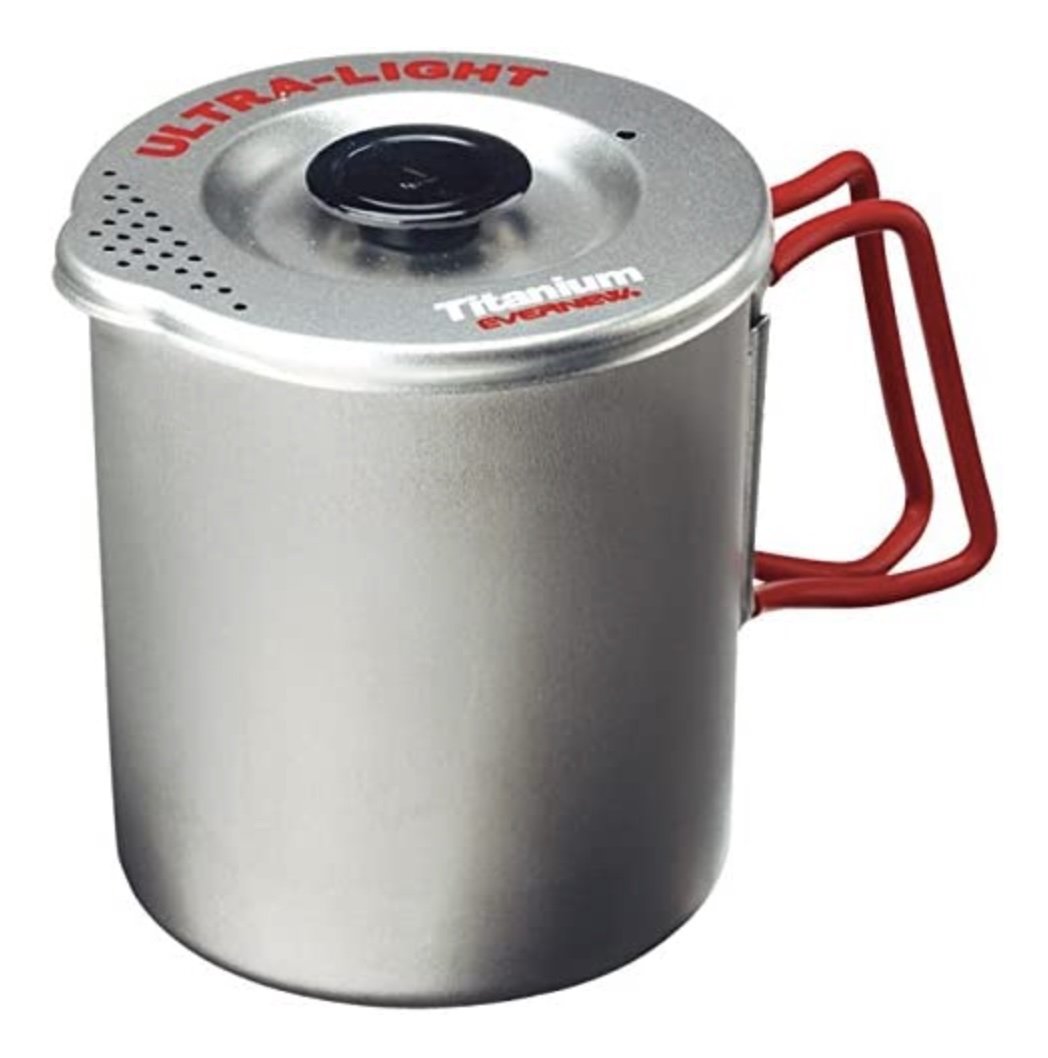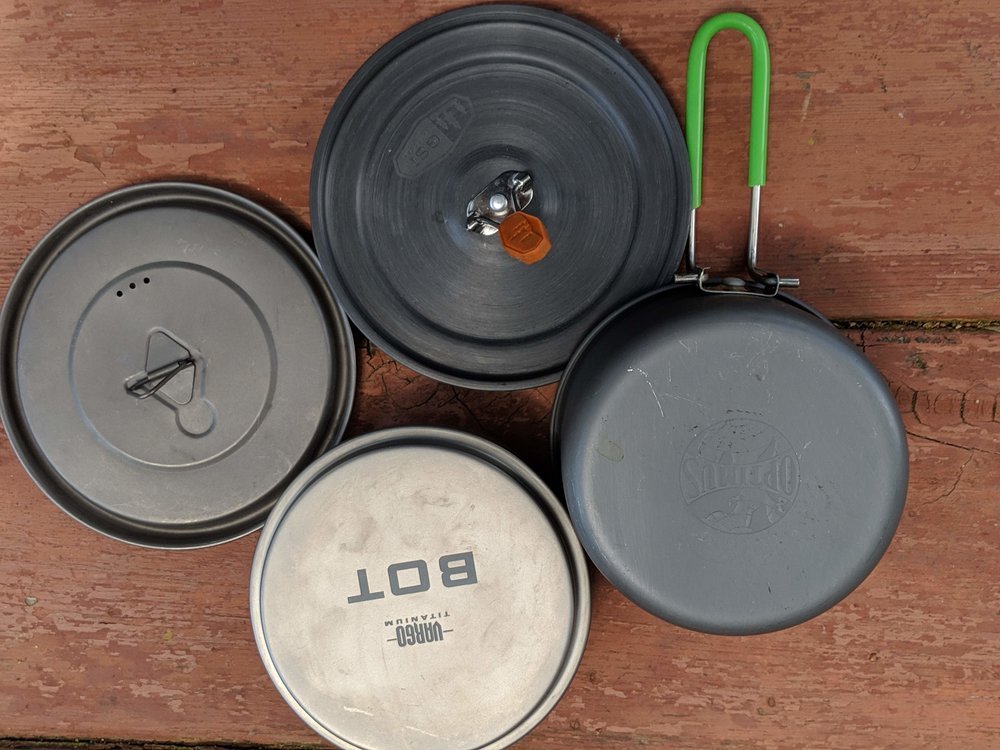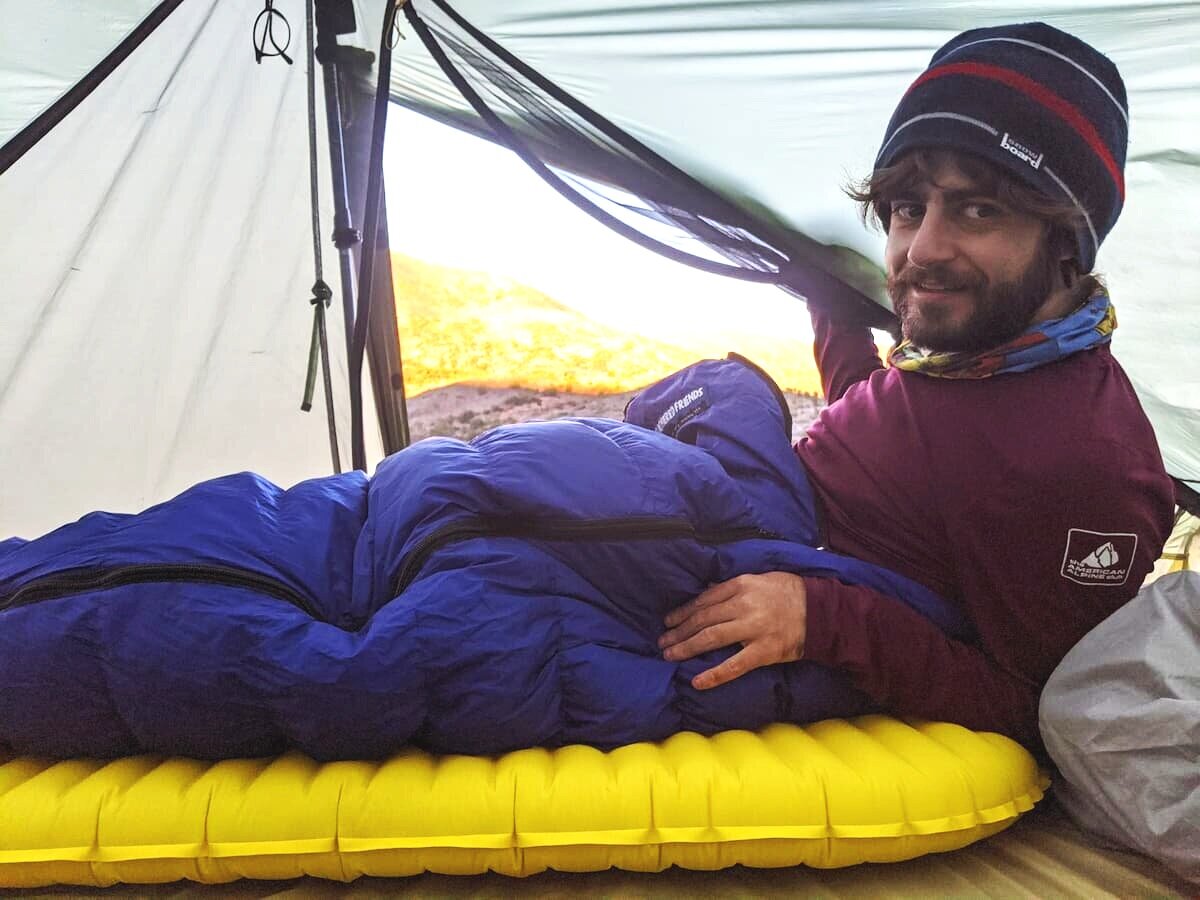Best Backpacking Cookware Pots of 2024
The Top Outdoor Cookware Pots and Nesting Sets for Backpacking
April 15th, 2024
Home > Gear Reviews > Backpacking
We researched and tested the most popular backpacking cooking pots to find the best cookware for all kinds of backpackers. From fast and light solo cook pots for thru-hikers to group cooking pots that cross over for car camping, we reviewed cookware based on weight, volume, compactness, and features.
We found the best backpacking cook pots, including options for hikers who prefer titanium, anodized aluminum cookware, stainless steel cooking pots, camping cookware nesting sets, budget picks, and non-Teflon non-stick pans.
We considered criteria important to backpackers like cooking efficiency, heat distribution, and most importantly, pots that are lightweight. The cookpots we considered work best with backpacking stoves vs. cooking over a campfire. If you are looking for a backpacking stove, check out our guide to the Best backpacking stoves.
We create reader-supported, objective gear reviews independently selected by our editors. This story may contain affiliate links, which help fund our website. When you click on the links to purchase gear, we may get a commission, without costing you an extra cent. Thank you for supporting our work and mission of outdoor coverage for every body! Learn more.
Comparison Table
| COOKING POT | TREELINE AWARD | RECOMMENDED SIZE | MSRP | WEIGHT | OTHER SIZES | MATERIAL | INSULATED HANDLE OR LID? | LIQUID MEASURING LINES? | PASTA STRAINER HOLES? |
|---|---|---|---|---|---|---|---|---|---|
| TOAKS 750 Titanium | Best Titanium Read why |
750 mL | $27 | 3.6 oz | 550, 650, 900, 1100, 1600 mL | Titanium | No | Inside pot | No |
| MSR Titan Kettle | Best Titanium Upgrade Read why |
900 mL | $65 | 4.4 oz | 2 L | Titanium | Lid Only | Inside pot | Yes, spout |
| GSI Outdoors Halulite | Best Anodized Aluminum Read why |
1.1 L | $40 | 8.6 oz | 2.3 L | Anodized Aluminum | Both | Inside and outside | No |
| MSR Ceramic Solo Pot | Best Non-Teflon Non-Stick Cookpot Read why |
1.3 L | $60 | 7.5 oz | 1.5 L, 2.5 L, skillet | Ceramic and anodized aluminum | Both | Inside pot | Yes |
| MSR Alpine Stowaway | Best Stainless Steel Cooking Pot Read why |
1.3 L | 25 | 13 oz | 475 mL, 775 mL, 1.1 L, 1.6 L | Stainless steel | No | No | No |
*See our Deals page for discounts on our favorite gear.
The Best Backpacking Cookware
Best titanium backpacking cooking pot: Toaks titanium 750 ml
Material: Titanium
Sizes available: 750 mL, 650 mL, 550 mL, 900 mL, 1100 mL (with pan), 1600 mL (with pan)
Weight: 3.6 oz
Insulated handle or lid? Neither
Liquid measuring lines: Inside
What we like: weight, price, lid and handles, compact shape, size availability
What we don’t like: not insulated handles or lid
The Toaks Titanium 750 mL cookpot is the #1 seller on REI and Amazon for a reason: it offers quality construction at an affordable price. The Toaks Titanium 750 wins our award for best backpacking cook pot, but it also wins our award for best budget titanium cook pot. This sleek, well-featured, and lightweight pot and just happens to be an excellent value, too.
The Toaks Titanium 750 mL has foldaway handles and a pot lid that provide just enough easy gripping to get the job done without adding unnecessary weight. It fits a 110g fuel canister and a stove while its shape and size make it relatively durable for titanium cookware.
While the Toaks Titanium pot is designed for minimalists, it works so well (and is so affordable) it’s well-suited for every lightweight backpacker. In fact, even if weight isn’t your main concern, there’s a lot of reasons to choose the Toaks over other pots.
I have thousands of miles of backpacking using the Toaks 750, including thru-hikes of the John Muir Trail, High Sierra Trail, Arizona Trail, Superior Hiking Trail and 1,500 miles of the Pacific Crest Trail. it continues to be my go-to pot.
Compare prices on the Toaks titanium 750 pot
The TOAKS 750 mL is a perfect diameter and height to stay steady and wobble free with most canister backpacking stoves. Here, we’re using it with the MSR Pocket Rocket Deluxe. Photo by Liz Thomas
Volume and shape
With the Toaks 750 mL, you can fit a 110g fuel canister and a small backpacking stove like the MSR Pocket Rocket 2 (see our Best Backpacking Stoves guide if you’re looking for one that will fit this pot). It also works with alcohol stoves, which we didn’t cover in our stove guide.
We think 750 mL is right in our target zone for a good volume for a solo trekker (or a group trekker who cooks their own meal). At 3.18 cups, it’s enough to make a typical freeze-dried meal and have hot cocoa after.
The 750 L pot fits well into most backpacking backpack side pockets and front mesh, which is not the case for all pots we tested.
Eating from a Toaks 750 mL pot on the Continental Divide Trail. Photo courtesy Whitney LaRuffa
Durability
The TOAKS 750 mL is also a great shape to give the titanium pot some extra durability. We were tempted to recommend the 900 mL TOAKs Titanium D130mm pot, which has a squat shape that distributes heat quickly. However, in our experience (and those of customer reviewers) that size/shape combo was much more prone to going from circular to oval and becoming slightly warped. The 750 mL, in comparison, can handle getting banged around in a pack better.
Minimalist design
The Toaks 750 mL has a handle, lid handle, and notches measuring the volume on the inside of the pot. These are all Must-Have features for a cookpot.
However, unlike our upgrade winner, the Toaks’ handles and pot lid handle are not covered in insulation as we find on the excellent contenders, the Evernew Titanium UL pot and the Snow Peak Trek. Instead, be prepared to use potholders or gloves to handle your material. Titanium is quite good at cooling quickly, so if you have patience, it shouldn’t be a big deal and is one of the reasons why this pot is nearly half the price of those with insulation.
Lid
The only complaint we’ve seen (and it’s true for most Titanium pots except for the MSR Titan) is that the lid doesn’t “snap” into the pot. The lid is fairly loose, which means it’s easy to pull it off. That can be a boon if you’d rather not burn yourself when removing a pot’s lid. But it also means that you’ll need care when draining water.
What to know about cooking with Titanium
Like all Titanium cookware, the Toaks 750 has a few drawbacks. Titanium spots when exposed to heat sources, so don’t expect your pot to look like new for long. It transfers heat more rapidly than other materials, so “real cooking” can lead to scorched food if you don’t watch it.
Like all Titanium cookware, the Toaks 750 mL cookpot is best if you boil water most of the time and are prepared to use a lower temperature when you do cook.
Best Titanium Cooking Pot with Insulated Handle: MSR Titan Kettle
Material: Titanium
Sizes available: 0.9 L and 1.4L
Weight: 4.2 oz
Insulated handle or lid? Lid
Liquid measuring lines: Yes, but not as intuitive as on other pots
What we like: secure lid that snaps into place, excellent pour control, insulated lid handle
What we don’t like: pricier than some pots, handles aren’t insulated, liquid measure lines not as intuitive as on other pots.
A perennial favorite of almost all the professional reviewers we surveyed, the MSR Titan Kettle is a pot that will stay in your collection for more than a decade. While the MSR Titanium Kettle is more expensive than other options, we think it’s worth paying extra for something that will likely last your entire backpacking career.
The MSR Titanium Kettle has the lightweight and design aspects we love in the Toaks 750 mL with some extra features that put it above the other pots we tested. Its greatest convenience is that the lid stays flush against the pot, meaning you can use it like a kettle--controlling liquid as it comes from the spout without worrying that the whole lid will fall off and spill water everywhere.
The MSR Kettle has a few benefits over our overall budget pick that we found well worth the extra money–including an insulated lid handle and insulated folding handles.
Compare prices on the MSR titan kettle
The new MSR Titan has an improved pour spot for more control. Unlike the previous model, there are now silicone-coated insulated handles on the lid and pot.
Updates in the new model
Updated for 2024, the MSR Titan kettles have a better spout for easy pouring and new silicone-coated handles on the lid and pot itself. My previous model only had an insulated lid handle. The new insulated handles fold closed for packing.
The lid is even more secure with a new snug-fit lid with a more robust knob design. It adds 0.2 oz, but most lightweight backpackers will find it worth for the convenience of not having to use a potholder.
The new MSR Titan cook pot has graduation marks on the inside and outside of the pot for easy measuring.
They've finally added internal and external graduation marks, which make for easy volume measurements. It seemed odd to me that the earlier iteration of the MSR Titan didn’t have graduation marks. I’m glad they fixed this issue!
Secure lid
The lid on the MSR Titan stays place even when holding the pot upside down. Warning: do not do this if liquid is inside! Photo by Liz Thomas
What convinced us the MSR Titan Kettle is the best pot titanium solo upgrade pot is that the lid snaps onto the pot, staying in place as you pour and allowing you to control the flow from the spout. This seems minor, but it makes a world of difference when cooking.
We also like that the lid is rolled, which gives it extra stability and reduces the risk that it will warp. Unlike the TOAKS 750 mL, our overall winner, the MSR Titan Kettle lid always has a consistent fit, whether you’re cooking a meal or stashing your cook set in your backpack. The snug lid on the MSR Titanium kettle also makes it reliable and not leaky when straining noodles.
Size and Volume
The MSR Titan Kettle is a good size for a solo backpacker. It fits a small backpacking stove and 110g fuel canister (see our Best Backpacking Stoves guide if you’re looking for a stove that will fit this pot). T
You can also cook ramen, rice, or a box of Mac & Cheese directly in the MSR Titan with some extra cocoa water to spare.
Best anodized aluminum cooking pot: GSI Outdoors Halulite boiler pot
The Halulite 1.1 L cookpot is an anodized aluminum pot with even heat distribution.
Material: Aluminum
Sizes available: 1.1 L, 1.8 L
Weight: 8.6 oz
Insulated handle or lid? Both
Liquid measuring lines: Inside and outside of pot
What we like: even burn that can handle temperature differences for ACTUAL cooking, insulated lid and handle, durability, price
What we don’t like: pricer than other aluminum pots, heavier than titanium
An REI and Amazon bestseller for hard-anodized aluminum, the GSI Outdoors Halulite 1.1 L Cookpot is an incredibly strong and affordable non-stick pot that can handle elaborate backcountry meals. If you intend to fish on your backpacking trip and cook what you catch, or just want some breakfast eggs, anodized aluminum will handle subtle temperature differences better than titanium. It’s more durable than titanium as well and comes with a non-stick coating that prevents meals from burning to the bottom.
Unlike titanium, the Halulite pot can also be used directly on a fire and on a stove and provides quick and even heat distribution. While many of the GSI’s benefits are true for all anodized aluminum pots, the Halulite has thoughtful features that make it easier to use than similar pots on the market.
Compare prices on the GSI outdoors halulite boiler pot
The Halulite 1.1 L pot has a handle that contracts and also secures the lid while your pot is in transit. To loosen the handle, press the two buttons on the side of the handle attachment area. Note that some people with arthritis or smaller hands found this to be difficult. Photo by Liz Thomas.
Insulated handles
One of the advantages of the Halulite over other anodized pots we considered is GSI’s thoughtful insulated handle system. Rubber-like insulation protects your hands from the heat when handling a hot stove.
Secure Lid
Its handles fold away and keep the lid in place when you’re storing your pot in your backpack (a nice feature compared to the TOAKS, which requires a rubber band to keep it in place). The handles keep the lid secure so well that one customer reported cold soaking oatmeal overnight in the stove while bear hanging the stove from a tree. That seems like a breakfast disaster waiting to happen, but it’s a testament to the secureness of the lid system.
Size
Like all the pots that made our winners list, the Halulite fits a fuel canister and backpacking stove inside (see our Best Backpacking Stoves guide if you’re looking for one that will fit this pot). The Halulite’s shape allows for it to work well as a pot, bowl, and mug without being awkwardly shaped for any of those uses. As this pot is larger than the others we considered, we were pleased to see that it can also fit a 450 mL mug inside.
At 1.1L, the Halulite may be too large for some solo backpackers. But couples found it to be the perfect size for two people.
For those cooking for groups, the Halulite pot is available in a 1.8 L size.
Measuring lines
Another nice feature of the Halulite is that it features liquid measuring lines that are visible on the inside and outside of the pot. This is notable because most pots choose one. They’re measured in ounces (oz) and mL so make it easy to add the correct amount of water to your freeze-dried meal, as some backpacking food brands only list one, forcing you to do some math to get dinner going.
Anodized aluminum
Anodized aluminum is heavier than titanium, so as a category, any anodized aluminum pot will be heavier than the titanium pots we tested. The Halulite is 8.7 oz for the 1.1L version. For comparison, the solo titanium TOAKS 750 mL, the lightest pot we considered, is 3.6 oz. Split across two campers, the 4.3 oz of the Halulite isn’t unreasonable—especially for a non-stick pot that can be put directly in a fire.
Value
The Halulite is slightly less expensive than the TOAKS titanium, though not by much. The main benefit of the Halulite is the durability and heat distribution benefits of aluminum over the lighter weight titanium. The Halulite is an affordable, reliable, durable option for backpackers who want more versatility in cooking than offered by titanium cookware.
Best Non-teflon non-stick cookpot: MSR ceramic solo pot
The MSR Ceramic pot is an aluminum anodized pot with non-stick properties that doesn’t use PFOA chemicals that some people choose to avoid.
Material: Fusion ceramic and anodized aluminum
Sizes available: 1.3 L, 2.5 L, 8” skillet, and 1.5 L (only in 2 pot set)
Weight: 7.5 oz
Insulated handle or lid? Both
Liquid measuring lines: Inside
What we like: non-Teflon no stick, excellent heat distribution for ACTUAL cooking, insulated easy to use lid and handle, pot with strainer
What we don’t like: price, no spout
If you’re avoiding non-stick cookware, but know you want to do more than boil water in the backcountry, we recommend the MSR Ceramic Solo Pot.
The new version of the MSR Ceramic Solo Pot has all the heat distribution benefits of other anodized pots without non-stick coatings—and even more durability.
Instead of a Teflon coating like found in other hard-anodized aluminum pots, it has an inert ceramic coating. This is ideal for backpackers and campers looking to avoid PFAS and PFC-free, which are common in waterproofing on outdoor apparel and in the manufacture of cookware. REI is aiming to remove all PFAS in outdoor apparel and cookware by 2025. This reflects bans or new regulations at the state level in California, Colorado, Maine, New York, Maine and Washington.
Compare prices of the MSR Ceramic solo pot
The MSR Ceramic Pot has a shiny non-stick bottom, a lid with insulated handle and pasta strainer, and an insulated handle that’s easier to attach/detach from the main pot than the handle on the GSI Halulite. Photo by Brian Davidson.
Eco-friendly
With Teflon or PFOA non-stick coatings, over time and with heat, the chemical components can flake off and enter your food. There’s some evidence that this isn’t healthy to consume, and as with all chemical exposure, risks increase with repeat exposure (i.e. as you consume it over many meals). There’s more evidence that the chemicals used to make Teflon can enter waterways and cause serious ecological problems during the manufacturing process.
Weight
While “ceramic” implies a heavier weight to many people, the MSR Ceramic Solo Pot is surprisingly lightweight.
In fact, at 7.5 oz, it is 1.2 oz lighter than the Halulite, the other hard-anodized aluminum cookware of the same size. It’s also a bigger pot than the Halulite, so well suited for two people.
At 3.75 oz per person, it’s the same weight per person as our lightest weight option, the titanium Toaks 750 mL.
Volume and capacity
Despite the name, this 1.3 L pot is actually a good size for two people at a weight per person that is just as light as the titanium pots we considered.
If you’ll be cooking for more than one or two people, it’s available in a Ceramic Two-Pot Set as well. It comes with a 2.5 L pot and a special 1.5 L pot that isn’t sold as a stand-alone. If you like the ceramic non-Teflon features of the pots, there is also a Ceramic Skillet in the series.
Best stainless steel cooking pot: MSR alpine stowaway 775 ml
Material: stainless steel
Sizes available: 475 mL, 775 mL, 1.1 L, 1.6 L
Weight: 13 oz
Insulated handle or lid? No
Liquid measuring lines: Inside
What we like: price, can go in a fire, well-featured for the price, variety of sizes, durability
What we don’t like: weight, no insulation
If you know you want to do some real cooking in the backcountry and don’t mind the extra weight, the MSR Alpine Stowaway is almost every professional reviewers’ favorite stainless steel pot. It’s a top seller at REI and Amazon and among our editors, especially for its ability to cook directly in a campfire.
The MSR Alpine Stowaway is affordable but still thoughtfully designed for backpackers. It is relatively compact. It is designed for backpacking, so is more compact and lightweight than other stainless steel stoves we considered including those by Stanley. Rounded corners push heat up along the sides for more efficient cooking, the thoughtful kind of feature that makes it a quality product, even at a budget price.
Compare prices of the MSR alpine stowaway
Unlike titanium cookware, stainless steel pots can go directly over a campfire.
Durability
As one may expect for a stainless steel cook set, the MSR Alpine Stowaway is by far the most durable pot we considered. If you intend to mostly car camp or don’t mind carrying extra weight, it’s hard to beat the MSR Alpine Stowaway for the price.
It’s an excellent pot for guides who want to cook up real meals and know that their pot will see so much use, it’s not worth risking a non-stick coating.
Advantages of stainless steel
Unlike other pots we considered, the MSR Alpine Stowaway has the advantages of stainless steel: including that it can be used directly in a fire.
Volume and Size
You can fit a 110g fuel canister and a small backpacking stove like the MSR Pocket Rocket 2 or the newer MSR Pocket Rocket Deluxe.
The 0.775 L size is the one we recommend for most solo adventurers. But it’s also available in the bigger 1.1 L and 1.6 L sizes if you will be cooking for two or more people.
Best cookset for camping: GSI outdoors pinnacle camper cookset
The GSI Pinnacle Cookset includes 2 pots, one frying pan, 1 pot gripper, 4 plates, 4 bowls, 4 sippy mugs, and a welded sink/stuff sack.
Material: Teflon-coated hard-anodized aluminum/polypropylene/nylon
Sizes available: one size serves 4 people
Weight: 3 lbs 10 oz (for 4 people)
Insulated handle or lid? Lid yes, handle no
Liquid measuring lines: Inside
What we like: designed to nest with each other, folding handles, very compact, everything for 4 people included
What we don’t like: weight
If you want to purchase one pot to cover the entire family’s camping or backpacking trip, the GSI Outdoors Pinnacle Camper cookset is the most widely recommended all-in-one set-up.
This multi-piece cook set has all the pots, pans, plates, bowls, and mugs you need for an outdoor trip and doesn’t require you to choose pots and pans piece-by-piece.
When looking at the GSI Pinnacle Cookset, it’s clear that the designer has backpacked and camped a lot with the goal of eliminating every common complaint a cook set user could have.
Mugs work for left and right-handed people. The pot gripper locks onto the side of the pots and pans at an angle where it’s impossible for it to scratch the pan’s nonstick coating. The carry bag can double as a sink basin.
While it’s odd to get excited about a cook set, it’s hard to not look at the GSI Pinnacle and think repeatedly, “Oh, that’s really clever!”
It’s a bestseller at REI and Amazon and is highly recommended by outdoor media and customers alike. The GSI Pinnacle has a well-thought-out design with well-executed features that make it the best camping cook set we've seen.
View the GSI outdoors pinnacle cookset
The GSI Pinnacle cookset includes more than 20 pieces of cookware.
Yet fits and packs away neatly into the largest of the two pots that it comes with.
What's included
First, what you get with the GSI Outdoors Pinnacle Cookset: 2 pots, a frying pan, 4 plates, 4 bowls, 4 mugs with sippy lids, pot gripper, and a welded sink/stuff sack to carry it all in.
This should be enough to cover a couple on a camping trip and you can get two to cover a family of four.
Durability
The hard-anodized aluminum pots and pans heat evenly for real cooking and frying in camp. The entire system is durable enough to last decades but lightweight enough to take on a short family backpacking trip.
Thoughtful features
What put the GSI Outdoors Pinnacle Cookset on top of other cook sets is the thoughtful features to make camp life easier. The pot lids come with easy-to-lift strainers to make draining pasta water easier. The mugs come with sippy lids so you won’t spill and insulators so small hands won’t burn on hot beverages.
Everything is color-coded so you can tell which set is yours and which piece got dragged off by a bear. All the pieces nest together to reduce space in your car’s trunk or backpack.
Dishwasher safe
Most importantly, everything is dishwasher safe for when you get home (so don’t bother doing dishes if you’re out for one night.)
Value
The downside of the GSI Pinnacle Cookset is it’s expensive. But when you consider the sheer amount of cookware pieces you get in the set, the price seems more reasonable. Sure, you could assemble a set of disposable or Dollar Store plastic plates and cups for a lower price, but the GSI Pinnacle is the sort of quality set that will last a childhood of car camping, backpacking, and canoe trips. Additionally, the plastic pieces are BPA-free, which you may not find so easily when assembling your own discount set.
Best pot for bikepacking and bicycle touring; Best for group backpacking: GSI outdoors escape 3L
Material: aluminum
Sizes available: 3L (just pot), 2L (just pot)
Weight: 1 lb 2.3 oz (2 L pot)
Insulated handle or lid? Both
Liquid measuring gradation lines: Inside
Occasionally, a piece of gear comes along that changes the way we think about gear. The GSI Pinnacle Escape 3L Pot and Frypan is one of those items.
Like the genius of foldable kayaks, GSI perfected the flat-lying foldable cookpot. It rides flat, so is perfect to strap onto a bike (where finding room for bulky cookware can be a hassle).
The flat system also works well for lightweight backpackers who are feeding a group but don’t want to carry an extra-large backpack to do so. Other brands are starting to do this design but we still find GSI's to have the several features that make it more convenient.
But perhaps most notably, we love this system for folks who live in small apartments or have limited space, who want to have quality camping equipment without requiring a lot of home storage space.
View the GSI escape 3L with frypan
The GSI Escape comes with every thoughtful and convenient feature a cookpot user could want: insulating handles, insulating thumb grips, and a pasta strainer. Photo by Liz Thomas.
Design
I’ve used the GSI Cookpot on car camping trips from Joshua Tree to road trips to Mesa Verde National Park. I love how it folds down flat for packing a fully-loaded cross-country road tripping car or a trunk full of car camping gear for the whole group.
The entire design is thoughtfully made for convenience. The sides are foldable silicone and the lid has integrated straining holes for draining pasta water. The handles, lid, and any part likely to touch skin have insulation. Dual locks keep the lid in place while traveling.
The GSI Escape 3 L with Frypan was one of the most clever pieces of gear we saw from tens of thousands of other innovations on display at Winter Outdoor Retailer (read our full story on innovative gear).
Fast Boil
It has a hyper conducting "Radiance Technology” heat sink that cooks 30% faster than a flat-bottomed pot (some people call this the Jetboil-style pot bottom).
The GSI Pinnacle pot can be used with the skillet to prepare more elaborate meals. The Skillet folds into the pot for convenient packing. Photo by Liz Thomas.
Integrated Skillet
The set includes a large 9” skillet that folds into the pot, compressing down to the size of a Frisbee. Because the fry pan doesn't add any additional bulk to the system, it makes it easier to pack in a pan to cook caught fish in the backcountry.
Use for bike touring and bikepacking
Treeline Review editor Brandon Lampley noted that this flat integrated design makes it ideal for attaching to a bike, making it ideal for bike tourers and bikepacking.
For those traveling on bike, space is at a premium. The GSI Pinnacle loads neatly onto a cargo rack or can fit into a frame bag and bigger saddle bags. We've even heard of folks fitting them into bigger handle bar bags!
Because it folds down, the GSI Escape 3L also works well for car camping, where packing a vehicle full of gear for everyone can sometimes be challenging without a van.
Honorable Mentions
Vargo Bot
Material: Titanium
Sizes available: 700L, 900 L
Weight: 4.8 oz
Insulated handle or lid? Neither
Liquid measuring lines: Inside
We love the idea behind the Vargo Bot, an innovative titanium pot with a screw-on lid that turns it into a bottle. An ultralight thru-hiker favorite, the Bot allows backpackers to use their cookpot as a cold soak jar or as extra water capacity. We tested both versions of the 900 mL–with handles and the lightweight version without a handle. We also tested the additional nesting bot bowl.
The bot eliminates the need for a separate cook pot and cold soaking jar for backpackers that like to have hot and cold backpacking meals. It weighs 4.8 oz–which is a a
It's also available as a 700 L version, which is the most popular size, the size we recommend. The height on the 700 mL is more secure on a canister stove than the tall 900 mL. Plus, it is lightweight and more affordable.
One issue we've had with the Bot is getting the lid off. We found the threading on the lid is difficult to line up correctly. With elevation change or changes in barometric pressure, removing the screw-on lid can be difficult.
Manufacturing precise notches into titanium can get expensive and we understand why this pot costs what it does. This is still a good option for ultralight backpackers and bikepackers or those with limited space who want to avoid redundancy in their system.
View the Vargo Bot
The Vargo Bot fits a canister and backpacking stove. The nesting mug fits around the base. The lid (right) screws onto the pot to turn it into a bottle.
Material: Titanium
Sizes available: 700 mL, 1L
Weight: 3.2 oz
Insulated handle or lid? Both
Liquid measuring gradation lines: Inside
The Evernew Titanium UL Pasta Pot is our Runner Up for Best Upgrade Titanium Pot. This pot is a long-time favorite of backpackers including Section Hiker and Greenbelly. We wanted to make it a winner, but the Evernew has significantly cut back their US distribution and this pot is getting increasingly difficult to find except at specialty shops or on Amazon. In the small chance that you aren’t happy with it, customer reviews complain that returns are nearly impossible.
We like that the Evernew Titanium pots are sturdier than our overall/budget pick, the Toaks Titanium 750 mL. The most stand-out feature on Evernew pots is that all the handles are insulated (not just the lid like on the MSR Titan Kettle).
An slight spout at the lip makes pouring from this pot easy. Here, the pot is shown on a section of the Pacific Northwest Trail in the Mt. Baker Wilderness in Washington. Photo by Liz Thomas.
This Evernew pot has a thoughtful pour spout lip, as found on the MSR Titan. If you can get your hands on the Evernew Pasta Pot, it’s well worth the price and will serve you for decades. Just don’t expect any refunds if you change your mind.
View the Evernew titanium pasta pot
Material: Titanium
Sizes available: 700 mL, 900 mL
Weight: 3.2 oz
Insulated handle or lid? Both
Liquid measuring gradation lines: Inside
The Snow Peak TItanium Trek 700 Mug is our runner-up for Best Titanium Cooking Pot and has long been a favorite of backpackers and was mentioned by Adventures Junkies and Section Hiker. It’s also an REI best seller.
But the Snow Peak Trek is in an uncanny valley of “more expensive and better featured than our budget/overall pick” while also being “less expensive but not as featured” as our upgrade pick. We had to draw the line somewhere. Nonetheless, the Snow Peak Trek is a great pot and highly recommended, especially if you can get it on sale.
View the Snow Peak titanium trek 700 mug
Material: Silicone
Sizes available: 1.1 L, 1.4 L
Weight: 7.1
Insulated handle or lid? Both
Liquid measuring lines: Inside
The Sea to Summit Frontier Ultralight Collapsible Kettle is for backpackers and bikepackers who want to reduce volume. It has the benefit of being a kettle, meaning that the lid stays on securely and snaps into place, similar to the MSR Titan Kettle. Ultimately, it's heavier than similar pots and the smallest size is 1.1 L, which is too big for most solo backpackers. Still, we think it's a good option for couples and groups, especially when space is at a premium.
View the Sea to Summit Frontier Ultralight Collapsible Kettle
Material: Silicone
Sizes available: 2.2 L
Weight: 10.5
Insulated handle or lid? Both
Liquid measuring lines: Inside
The Sea to Summit Frontier Collapsible Pot is for backpackers and bikepackers who want to reduce volume. Like the kettle, it collapses. Only the bottom is made of metal.
It has a similar design to the GSI Outdoors Escape Pot with the difference that the Escape Pot has a Jetboil-style bottom that heats up faster. We also found the bottom more keeps bigger pots more secure when using on small backpacking stoves.
We still think the Sea to Summit Frontier is an excellent option and it's more widely available. If you're unable to locate the Escape Pot, the Frontier is a versatile pot made of quality materials and will last a long time.
View the Sea to Summit Frontier Ultralight Collapsible Pouring Pot
Material: Titanium
Sizes available: 750 mL, 900 mL, 1200
Weight: 3.7 oz
Insulated handle or lid? No
Liquid measuring gradation lines: Inside
Treeline writers have given the TOAKS 550 mL a thousand miles of backpacking use and abuse, but concluded it’s too small to cook up enough food for most adventurers.
Treeline Review writer Kate Hoch reports, “I got the [this pot] purely to save on weight knowing I just needed to boil a little water. But it’s really not much weight savings.” We recommend the 750 mL version. It weighs 1.0 oz more, but is far more useful than this mini “pot.”
If you do go with the 550 L to save weight, it’s important to note it doesn’t fit a full ramen packet. It definitely doesn’t fit a box of Mac N’ Cheese. This pot is best for those who eat dehydrated refried beans or mashed potatoes already portioned into a ziplock bag.
COMPARE PRICES OF THE TOAKS LIGHT TITANIUM 550ML POT
Material: Titanium
Sizes available: 750 mL, 900 mL, 1200
Weight: 2.6 oz
Insulated handle or lid? No
Liquid measuring gradation lines: Inside
We purchased and used the TOAKS 900 mL D130mm (wide) for thousands of miles but ultimately found the 750 mL version (our Overall/Budget Pick) to be a size and shape that better holds up to the weathers of backpacking. We haven’t tested it yet, but are more optimistic that the TOAKS 900 mL D115mm has the rigidity of the 750 mL version that we recommend. It’s a good option if you like the 750 mL version but want a little more space.
VIEW THE TOAKS TITANIUM 900ML D130MM
The author testing various cook sets and pots in Northern Idaho. Photo courtesy Liz Thomas.
How We Researched
To research this guide, we used our own experience and paired it with review-based meta-research. To complete the meta-review, we read the dozen top articles on cooking pots and analyzed them to determine the most popular models recommended across multiple review sites. We also included the most popular models on REI and Amazon. Then we read hundreds of customer reviews. What we were left with is the top cookpot models for most backpackers and campers.
The professional review sites we analyzed were Adventures in Stoving, Adventure Junkies, Backpacking Light, Bike Magazine, Greenbelly, Outdoor Gear Lab, Reddit, Section Hiker, and TrailGroove.
We also read numerous posts on forums like Reddit and Backpacking Light to inform our decisions. See our Sources section for links and more info on specific articles that we found useful during the research phase.
Liquid gradation lines on the inside and outside of the pot can help you portion just the water you need to make freeze-dried meals or the perfect cup of coffee. Photo by Liz Thomas
Buying advice
All the cooking pots we considered have multiple review sites recommending them as well as happy customer reviews. Because we considered a variety of materials from titanium to ceramic, weight, cooking efficiency, and even cooking differed significantly. However, across all the pots that made our short-list, we took this non-negotiable criteria into account. All the pots that made our short-list came with these attributes:
Cooking pot volume
We considered pots 750 ML to 1.3 L in volume. This is widely considered to be the ideal volume range for most solo or couple cookers according to numerous forums on Reddit, Backpacking Light, and my favorite backpacking book, Ultralight Backpackin’ Tips by Mike Clelland.
It’s the perfect size to make a freeze-dried meal (plus have extra hot water for hot cocoa). It also is big enough to simmer a full package of ramen noodles, box of Mac N Cheese, or cook up oatmeal, rice, or spaghetti (break the noodles in half!). You can save weight with smaller pots, but having carried a 550 mL before, our writers have found it’s annoying to have to boil water multiple times to get enough water for a full meal.
Cooking pot handles
The foldaway handle on the MSR Ceramic pot was the easiest and most intuitive handle system we saw on a cookpot. Photo by Liz Thomas
We’ve tried pots without handles like the original version of the Vargo Bot (a bottle-pot that comes with a screwable lid but no handles). While we appreciate the weight savings, a handle-less design is inconvenient for all but the most gram-saving weenies.
We prefer pots with a bit of rubber insulation on their lid and side handles to avoid burns from handling a hot pot. But we didn’t hold it against a pot if it lacked the insulation. As backpackers who are sensitive to weight, we know that most of the time, a pair of wool gloves will do the trick (be wary of those with high synthetic fabric mixes, which can melt when exposed to heat).
Cooking pot size and shape
If you’re backpacking with your camping equipment, size and shape of your pot should be one of your top criteria in choosing a pot. To make our short list of cookpots, all the pots had to be of a size and shape that could hold a 110g fuel canister and a small backpacking stove.
Cook pot size and shape impact stability, packability, and fuel efficiency.
Packability
A big pot may not fit nicely into the outside front mesh pocket of a backpack, which is our preferred spot to stash cookware. Why? Because cookware can afford to get wet (unlike stuff that needs to stay inside your backpack to stay dry, like your warm clothes). A cookpot also may have residual soup or soot on the outside, so keeping it outside your pack is good practice to reduce the chance that food odors and juices may end up on your sleeping bag.
Fuel Efficiency
Squatter pots like the TOAKS 900 mL D130 wide pot that we tested, can have some benefits. They tend to be less tippy than tall pots. They also are slightly more efficient at using fuel and cooking quickly. This is because the flame hits a wider surface area of the pot so more heat transfers to your pot’s contents more quickly.
Ideally, your pot is just slightly wider than your burner’s diameter so it’s able to capture your flame and the hot exhaust gas that otherwise would escape from the sides. Squatter pots also fit more flatly in your backpack making them more convenient for packing and (theoretically) better for weight distribution in your backpack.
Stability
We’ve found that squatter titanium pots can also be more susceptible to warping and turning from circular to ovaloid. Pot size and shape are a balance of usefulness vs. structural durability. It’s a spectrum. Backpackers’ tolerance for one benefit over the other will vary.
Different pots have different handles, insulation lids, and lips. Photo courtesy Liz Thomas.
Cooking Pot Lids, Spouts, and Strainers
The least sexy part of choosing a pot is actually sophisticated. Just like cooking at home, lids keep heat inside your pot which reduces the amount of fuel needed to boil water (and also time to do so). A snug lid keeps heat in better, but some aluminum foil can do the trick, too.
Lids also reduce splatter. While reducing splatter is a nice feature of a pot in a home kitchen, when you’re in bear country, it’s nice to keep all your smelly food on one pot instead of all over your camp.
But cookpot lids can get quite sophisticated when it comes strainers, spouts, and handles. Strainers allow you to drain that pasta water quickly. Spouts turn a pot into a kettle, especially if they stay on well like on the MSR Titan.
To make our short list, all cookpots had to come with a lid, preferably with handles. We gave extra points to pots that had a way to secure their lid to the pot, at least while in transit if not during the cooking process.
Cooking pot liquid quantity gradation markings
Most of our picks have notches in their material to indicate how much water is in your pot and help with measurements. Most notches are in mL and ounces. The best notch systems are visible from the inside of the pot. If you have a pot that does not have a notch system, we recommend this practice at home: fill your pot with desired measurements then put your camping spoon into the pot. Note where the water level reaches on your spoon and make a notch on your spoon with a knife or oil-based Sharpie. Next time you’re camping and need a measurement, put your spoon in the pot and measure water up to the notch on your spoon.
How to Choose The Cookpot For You
All the pots that made our shortlist meet our minimum criteria to be an excellent pot. But to find the pot from that list that will work best for you, you need to think about your outdoor needs. For additional reading, see REI’s Advice on How to Choose a Cookpot.
These questions will direct you to find the right cook pot for you:
Are you car camping or backpacking or bicycle touring or bikepacking?
Bikepacking and backpacking
The author using the TOAKS 900 mL wide-sized pot on the Pacific Northwest Trail. Photo courtesy Naomi Hudetz.
If you’re backpacking you’ll want something lightweight. It should stay stable on a backpacking stove, avoiding becoming tipping or tall enough to be top heavy. Backpacking cookware should also try to maximize surface area hit by your backpacking stove’s flame.
After all, if you carry in the fuel, you’ll want your cook system to be as efficient as possible. Backpackers care about weight, though they may be willing to carry something heavier if they intend to cook up a fish they caught in the backcountry or otherwise make a “real” meal. Lightweight backpackers may only want to boil water for a freeze-dried meal, so can get away with lighter weight titanium pots. To learn more about preparing for backpacking, see our article on How to Get Started Backpacking.
Car camping
If you’re car camping, chances are you’ll be cooking on a grill or two-burner Coleman Classic Propane Campstove. If that’s the case, you’ll want a flat-bottomed piece of cookware that can afford to be heavy. Chances are if you’re car camping, you’ll want to show off your backcountry gourmet skills to friends and family. We recommend a hard-anodized aluminum cookpot as well as a ceramic non-stick pot that can handle subtle changes in temperature for simmering, baking, and sautéing. Our favorites for camping are the GSI Escape Pot + Frypan or the GSI Pinnacles pot set.
If you intend to put your cookware directly into a campfire, stainless steel is the only material that manufacturers recommend can survive that kind of flame. The MSR Alpine Stowaway (our best stainless steel pick) is the pot that we’d recommend.
If you’re car camping, you will likely have more burners available and should get as many pots as you have burners. You’ll also want plates, deep bowls, and mugs as well as a frying pan. For this story, we’re only considering cooking pots, although the GSI Pinnacle cookset that we recommend includes a pot, pan, plates, bowls, and mugs.
If you’re bikepacking or bicycle touring: packability will be your biggest priority. See our guide to How to Get Started Bikepacking or our Bike Touring Packing List for more information.
What’s your budget?
You can get the lightest cookpot out there made of titanium, but aluminum is slightly heavier and a heckuva lot more affordable. Anodized aluminum conducts evenly (it’s often used as a material for the pots and pans in your kitchen, too). But it can be more expensive and often comes with a non-stick coating that some folks may wish to avoid.
How durable does this need to be? are you ok with hot spots getting discolored?
Titanium and aluminum are lightweight, but can warp, dent, and scratch easily. This can really drive some people nuts.
Titanium and stainless steel are sensitive to discoloration in the area closest to the flame. But stainless steel cookware will survive some serious backcountry abuse, even if it turns a funky color. Stainless steel is the only material that manufacturers suggest will be ok if you put it in a campfire.
If you know you’re tough on gear, or are backpacking with kids, you may want something heavier duty, like anodized aluminum or stainless steel. Somewhat less robust but better for even cooking, hard-anodized aluminum is the most durable and resists dents and scratches you may normally experience while camping.
What’s your cooking style?
Your cooking style will determine your preferred cookware material. While we recommend anodized aluminum for car campers, if you know you’re the type of backpacker who goes all out on making a backcountry feast, lightweight anodized aluminum cookware will be your best friend. Hard anodized pots take longer to cool than other materials but are corrosion resistant.
Are you cooking, simmering, baking, or boiling water? How much does heat distribution matter to you?
If you’re cooking eggs, fresh meat, or veggies, go with hard-anodized aluminum. Real ingredients (aka, not pre-packaged freeze-dried or dehydrated) are more sensitive to temperature changes while cooking and will appreciate how hard-anodized aluminum can evenly spread the heat across the pot. Hard anodized aluminum has a better heat distribution than other materials, making it better for cooking real ingredients.
Aluminum is best for conducting heat (think simmering without burning the bottom of your pan). Even if you’re cooking soup, if it requires a simmer, the aluminum pot can usually handle that job better than titanium (which can get soup chunks burnt to the bottom of the pot).
If you know you’ll mostly be boiling water in the backcountry, titanium cookware is the lightest material and will do the job. It’s the favorite cookpot of those going fast and light like thru-hikers, alpine climbers, and bikepackers.
How much weight are you willing to carry?
Different outdoors people have different Willingness to Carry Weight. That’s why we considered pots of different weights.
As mentioned above, thru-hikers, alpine climbers, and bikepackers with fast and light goals will likely prefer a titanium pot. Titanium cookware is about 45% lighter than steel and stronger than aluminum, according to Outdoor Gear Lab (see Sources).
Backpackers and adventurers who intend to catch fish or forage for mushrooms and fry them up may prefer a pan that can distribute heat more evenly and prevent scorched food, like anodized aluminum or ceramic. Anodized aluminum is, in our calculations, about 150% heavier than a titanium pot of the same size.
Campers concerned about durability and price may prefer a stainless steel pot. It’s the heaviest but will last a long time (and is the only material that can safely go directly in a campfire).
Do you avoid teflon? What do you think of non-stick coatings?
Forever chemicals like PFAS and PFCs are found in outdoor apparel waterproofing and in cookware. Many outdoors people are concerned about potential dangers associated with non-stick materials like Teflon. As a result, REI is phasing out cookware with PFAS and many outdoors people are thinking more about the coatings on their pans.
When you’re at home, it’s relatively easy to avoid scratching Teflon-like non-stick home cookware. In the backcountry, there’s a high likelihood that a scratch will develop during the packing or unpacking phase or as your cookware jostles around in your backpack.
Additionally, the manufacturing of non-stick cookware may release forever chemicals into the environment.
Ceramic non-stick coatings are popular in home cookware and are beginning to appear in outdoor cookware as well. Unlike Teflon, the non-stick materials that flake off into your food are inert. This is in contrast to Teflon and other chemical non-stick materials, which some scientists believe could potentially have harmful effects on human or ecological health.
As far as Titanium or Stainless Steel cookware, there’s no non-stick coating. Don’t expect the non-stick coating to prevent your food from sticking to the bottom if you do any actual cooking. But also, you don’t have to worry about potential health risks from that non-stick coating, either.
The GSI Pinnacle uses a super efficient cooking pot bottom that transfers heat better with heat exchanging fins. Photo by Liz Thomas
How much does efficient cooking matter to you? how quickly does your pot cook food?
As we wrote in our backpacking stove guide, fuel efficiency usually should not be a top concern for solo outdoor cooks. The exception is if you are out in the boonies in a place where it will be impossible to replenish your fuel supply, as some international trips. Especially long trips (7 days or more between resupplies) may also require you to worry more about fuel efficiency. Group guides who are cooking for multiple people may want to consider efficiency. Lastly, and perhaps most of note, if you anticipate having to melt snow to get water, you may want a more efficient pot (and stove).
Outdoor Gear Lab reports that a cookpot can transfer heat better if it has heat exchanging fins on its base, like that found on the GSI Pinnacle Pot, our winner for group backpacking, camping, and bikepacking, and bicycle touring. These fins have welded or soldered a circular ring of corrugated metal that captures heat, preventing it from escaping it to the sides. The captured heat is redirected towards the inner circle of the pot to speed up cooking. Outdoor Gear Lab reports that these heat exchange rings can boil water 24% faster than pots without (see Sources).
Backpacking pots care and maintenance tips
Although most backpacking cook pots are made to withstand drops and everyday use in rugged terrain, it still pays to take some care and to maintain it properly when you get home.
When you're on the trail or camping, best practices say to rinse it with hot water immediately after getting any food in there. That prevents food from sticking and potentially burning.
When you get home, you can take a crack at tougher stains using mild soap. If you're motivated, you can have at it with biodegradable soap in camp.
Most pot manufacturers say that abrasive scrubbers are a no-no–especially if your pot has any non-stick coatings. Soft sponges or a gentle brush should do the trick and some brands like Optimus even sell ones designed for use on their non-stick cookware.
When you get home or if you're roadtripping and won't be camping for a few days, completely dry your pot after cleaning and before packing it away. Trust me –you don't want mold and mildew growth, which can be an issue if you live in a humid place or store your gear in a moist basement. Use a clean cloth to wipe them dry and pay special attention to crevices and seams where water may collect.
When storing your cookware, a good tip is to store them pots with lids off. This gives them a little more air circulation and can prevent corrosion in case you accidentally didn't dry it all the way.
Many cook pots, like those made by TOAKS, come with a mesh bag to keep your cookware organized within your backpack. This minimizes the risk of scratching during transport or during your backpacking trip, though some ultralight backpackers like myself may choose to ditch the bag.
Lastly, before your trips, give your pots a check for signs of cracks, dents, rusting, or loose handles. Additionally, tighten any loose screws or handles as needed. This can be an issue with some of the models with clever holding handles, like the GSI Pinnacle.
FAQ
Are backpacking cookware pots dishwasher safe?
While some backpacking cookware pots may be labeled as dishwasher safe, it's generally recommended to hand wash them to prolong their lifespan. Dishwashers can be harsh on lightweight materials and may cause damage to non-stick coatings. That being said, I wash all my titanium cookware in my dishwasher at home and have never had an issue.
How do I prevent food from burning or sticking to backpacking cookware pots?
To prevent food from burning or sticking, follow similar practices at at home on your range. The trick is that backpacking and camping stoves can be harder to control temperature than at home–so if nothing else, turn that heat down low.
As you would at home, ensure the cookware is adequately preheated before adding ingredients. Use a moderate heat setting and stir the food regularly during cooking. Applying a thin layer of cooking oil to the pot's surface can also help prevent sticking.
Can backpacking cookware pots be used for cold meals or food storage?
Totally! Yes, backpacking cookware pots can be used for cold meals or food storage. Cold mashed potatoes, cold soaked backpacking meals, cold drink mixes, or storing leftovers are all fair game in a cook pot. The key is to 1) make sure that lid stays secure 2) clean them thoroughly before and after use to prevent contamination. Why? With cold food and leftovers, there's an increased risk of food contamination and foodborne illness. So seriously–clean that pot before and after if you're doing cold stuff.
What are some safety tips for using backpacking cookware pots?
When using backpacking cookware pots, always handle them with care to avoid burns or spills. Use pot grippers or insulated handles to protect your hands from heat. Ensure the pot is stable on the cooking surface to prevent accidents, and never leave a hot pot unattended. Lastly, be sure to keep flammable stuff far from your backpacking stove and follow fire bans. And kids and pets–they probably want to stay away from your pot, too.
The author cooking up broccoli in one of the TOAKS pots that we tested on the Pacific Northwest Trail, a 1200 mile long backpacking trip from Montana to the Pacific Ocean. Photo courtesy Naomi Hudetz.
Author’s Expertise & Why you should trust us
I’ve backpacked 18,000+ miles, most of it carrying a stove and cookpot. While I’m known for breaking the Fastest Known Time on the 2,181-mile long Appalachian Trail (women’s self-supported) and for first known traverses of the Wasatch Range and Chinook Trail, I’ve learned to relish the joy of a leisurely backpacking trip with multiple hot meals throughout the day and plenty of warm beverages.
I’m a lover of food—preferably hot. This love spurred me to create a subset of backpacking called “urban thru-hiking.” I’ve been called a "thru-hiking legend" and the “Queen of Urban Hiking” by Outside Magazine for innovative backpacking routes through cities. But really, it was just an excuse for good eating.
As a hot food aficionado, I’ve cooked dinner and lunch and hot coffee on many a chilly backcountry trip. Over years of adventures, I’ve taken more than a dozen cookpots on months of use and have opinions on this humble-seeming piece of gear.
In addition to using gear during my adventures, I write about outdoor gear for numerous publications including the Ask a Thru-hiker column in Backpacker and the New York Times’ product review site, Wirecutter.
My book, the National Outdoor Book Award-winning Long Trails: Mastering the Art of the Thru-hike, has chapters on gear, cooking, and nutrition — all of which are relevant to finding a good cookpot. Additionally, I regularly speak to outdoor clubs, non-profits, and universities about backpacking as well as gear clinics. Here at Treeline Review, I’m Editor-in-Chief and oversee all of our outdoor gear guides.
You can see all of Liz’s stories at her author page or at her website, eathomas.com.



